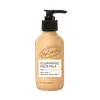What's inside
What's inside
 Key Ingredients
Key Ingredients

 Benefits
Benefits

 Concerns
Concerns

 Ingredients Side-by-side
Ingredients Side-by-side

Water
Skin ConditioningAloe Barbadensis Leaf Extract
EmollientGlycerin
HumectantCitrus Aurantium Amara Flower Water
MaskingCetyl Alcohol
EmollientGlyceryl Stearate
EmollientHelianthus Annuus Seed Oil
EmollientCocos Nucifera Oil
MaskingAvena Sativa Kernel Flour
AbrasiveSimmondsia Chinensis Seed Oil
EmollientPrunus Amygdalus Dulcis Oil
Skin ConditioningCitrus Grandis Peel Oil
MaskingPelargonium Graveolens Flower Oil
MaskingCitrus Aurantium Amara Leaf/Twig Oil
MaskingCitrus Aurantium Amara Flower Oil
MaskingTocopherol
AntioxidantSodium Stearoyl Lactylate
EmulsifyingDehydroacetic Acid
PreservativeBenzyl Alcohol
PerfumingLimonene
PerfumingLinalool
PerfumingCitronellol
PerfumingGeraniol
PerfumingWater, Aloe Barbadensis Leaf Extract, Glycerin, Citrus Aurantium Amara Flower Water, Cetyl Alcohol, Glyceryl Stearate, Helianthus Annuus Seed Oil, Cocos Nucifera Oil, Avena Sativa Kernel Flour, Simmondsia Chinensis Seed Oil, Prunus Amygdalus Dulcis Oil, Citrus Grandis Peel Oil, Pelargonium Graveolens Flower Oil, Citrus Aurantium Amara Leaf/Twig Oil, Citrus Aurantium Amara Flower Oil, Tocopherol, Sodium Stearoyl Lactylate, Dehydroacetic Acid, Benzyl Alcohol, Limonene, Linalool, Citronellol, Geraniol
Water
Skin ConditioningAloe Barbadensis Leaf Juice
Skin ConditioningLauryl Glucoside
CleansingCoco-Glucoside
CleansingRosa Damascena Flower Water
MaskingGlycerin
HumectantRosa Damascena Flower Oil
MaskingRosa Damascena Flower Extract
MaskingPelargonium Roseum Leaf Oil
PerfumingSodium Hyaluronate
HumectantXanthan Gum
EmulsifyingCedrus Deodara Wood Oil
MaskingCitric Acid
BufferingSodium Levulinate
Skin ConditioningPotassium Sorbate
PreservativePhytic Acid
Phenethyl Alcohol
MaskingSodium Hydroxide
BufferingPentylene Glycol
Skin ConditioningSodium Benzoate
MaskingCitronellol
PerfumingGeraniol
PerfumingLinalool
PerfumingWater, Aloe Barbadensis Leaf Juice, Lauryl Glucoside, Coco-Glucoside, Rosa Damascena Flower Water, Glycerin, Rosa Damascena Flower Oil, Rosa Damascena Flower Extract, Pelargonium Roseum Leaf Oil, Sodium Hyaluronate, Xanthan Gum, Cedrus Deodara Wood Oil, Citric Acid, Sodium Levulinate, Potassium Sorbate, Phytic Acid, Phenethyl Alcohol, Sodium Hydroxide, Pentylene Glycol, Sodium Benzoate, Citronellol, Geraniol, Linalool
Ingredients Explained
These ingredients are found in both products.
Ingredients higher up in an ingredient list are typically present in a larger amount.
Citronellol is used to add fragrance/parfum to a product. It is often derived from plants such as roses. In fact, it can be found in many essential oils including geranium, lavender, neroli, and more. The scent of Citronellol is often described as "fresh, grassy, and citrus-like".
Since the Citronellol molecule is already unstable, Citronellol becomes irritating on the skin when exposed to air.
Citronellol is a modified terpene. Terpenes are unsaturated hydrocarbons found in plants. They make up the primary part of essential oils.
Citronellol is not able to be absorbed into deeper layers of the skin. It has low permeability,
Citronellol is also a natural insect repellent.
Learn more about CitronellolGeraniol is used to add fragrance/parfum to a product. It is the main component of citronellol. It is a monoterpenoid and an alcohol.
Monoterpenes are naturally found in many parts of different plants.
Geraniol can be found in many essential oils including Rose Oil and Citronella Oil. The scent of Geraniol is often described as "rose-like". Many foods also contain Geraniol for fruit flavoring.
Geraniol can irritate the skin when exposed to air. However, irritation depends on the ability of geraniol to penetrate into the skin. In general, geraniol is not able to penetrate skin easily.
Geraniol is colorless and has low water-solubility. However, it is soluble in common organic solvents.
Like citronellol, it is a natural insect repellent.
2,6-Octadien-1-ol, 3,7-dimethyl-, (2E)-
Learn more about GeraniolGlycerin is already naturally found in your skin. It helps moisturize and protect your skin.
A study from 2016 found glycerin to be more effective as a humectant than AHAs and hyaluronic acid.
As a humectant, it helps the skin stay hydrated by pulling moisture to your skin. The low molecular weight of glycerin allows it to pull moisture into the deeper layers of your skin.
Hydrated skin improves your skin barrier; Your skin barrier helps protect against irritants and bacteria.
Glycerin has also been found to have antimicrobial and antiviral properties. Due to these properties, glycerin is often used in wound and burn treatments.
In cosmetics, glycerin is usually derived from plants such as soybean or palm. However, it can also be sourced from animals, such as tallow or animal fat.
This ingredient is organic, colorless, odorless, and non-toxic.
Glycerin is the name for this ingredient in American English. British English uses Glycerol/Glycerine.
Learn more about GlycerinLinalool is a fragrance and helps add scent to products. It's derived from common plants such as cinnamon, mint, citrus, and lavender.
Like Limonene, this ingredient oxidizes when exposed to air. Oxidized linalool can cause allergies and skin sensitivity.
This ingredient has a scent that is floral, spicy tropical, and citrus-like.
Learn more about LinaloolWater. It's the most common cosmetic ingredient of all. You'll usually see it at the top of ingredient lists, meaning that it makes up the largest part of the product.
So why is it so popular? Water most often acts as a solvent - this means that it helps dissolve other ingredients into the formulation.
You'll also recognize water as that liquid we all need to stay alive. If you see this, drink a glass of water. Stay hydrated!
Learn more about Water